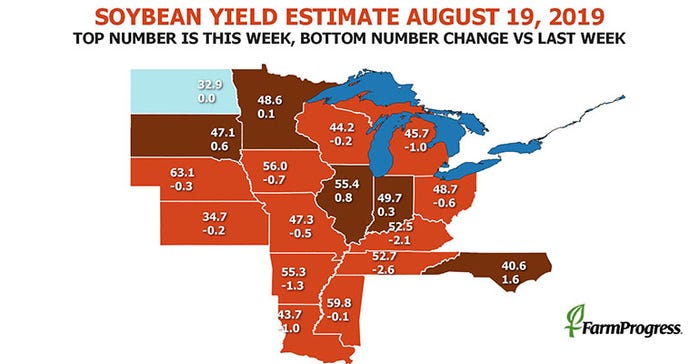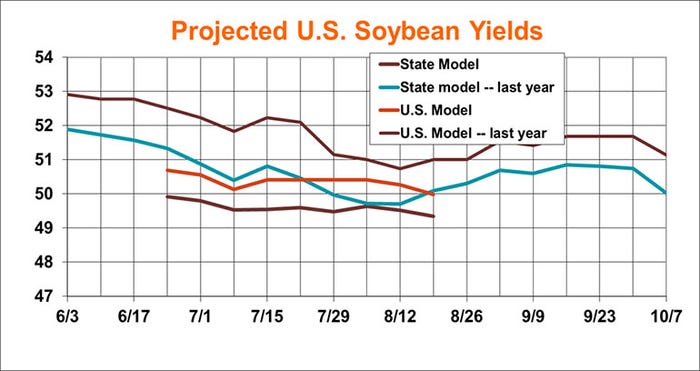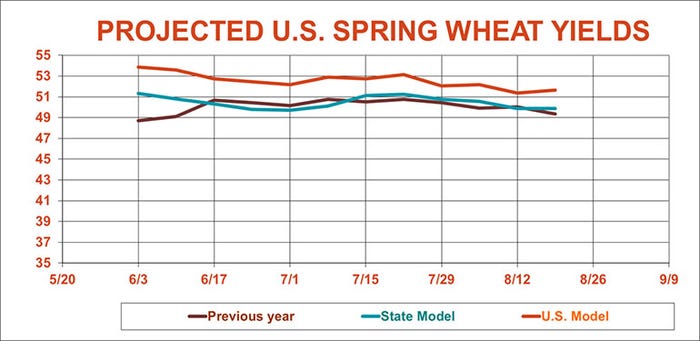
Analysts expected USDA to keep corn and soybean quality ratings unchanged for the week ending August 18. But the agency’s latest crop progress report, out Monday afternoon, showed both crops losing a bit of ground this past week.
“A drop in corn and soybean ratings could provide a little support to markets badly in need of a lifeline after selling resumed on Monday,” notes Farm Futures senior grain market analyst Bryce Knorr.

USDA marked 56% of the U.S. corn crop in good-to-excellent condition, down a point from the agency’s August 11 report. Another 30% of the crop is rated fair (unchanged from a week ago), with the remaining 14% rated poor or very poor (up a point from a week ago).
“Corn yield potential slipped around three quarters of a bushel per acre to an average of 168.6 bpa, almost a full bushel below USDA’s estimate last week,” Knorr says. “Models based on crop ratings ranged from 168 to 169.3 bpa.”

Physiologically, the crop remains well behind average for this time of year. Ninety-five percent of the crop is now silking, 55% is at dough stage and 15% is dented. All maturity levels remain significantly slow compared to 2018’s pace as well as the prior five-year average.
Soybean crop condition also tilted downward last week, with 53% of the crop now in good-to-excellent condition. Another 33% of the crop is rated fair (unchanged from last week), with the remaining 14% rated poor or very poor (up a point from last week).

“Soybean ratings lost the equivalent of a quarter bushel per acre, with the average of the two models down to 49.7 bpa,” Knorr says. “That’s 1.2 bpa above the 48.5 reported last week by USDA. Our two models ranged from 49.3 bpa to 50 bpa.”
Physiologically, 90% of the crop is now blooming, versus 2018’s pace of 99% and the prior five-year average of 96%. And 68% of the crop is now setting pods, versus 2018’s pace of 90% and the prior five-year average of 85%.


Spring wheat crop conditions firmed, in contrast, with 70% of the crop now in good-to-excellent condition after improving a point from last week. Another 23% of the crop is rated fair (unchanged from a week ago), with the remaining 7% rated poor or very poor (down a point from a week ago).
“After falling last week spring wheat yield potential improved a little this week, coming in at 50.75 bpa, in a range from 49.9 to 51.6 bpa,” Knorr says. “USDA raised its forecast of spring wheat production last week, putting the yield at 49.2 bpa.”

Harvest progress was more sluggish last week than analysts anticipated, meantime, after reaching 16% completion. That doubled the prior week’s pace of 8% but remains significantly behind 2018’s pace of 56% and the prior five-year average of 49%.
And winter wheat harvest is one step closer to completion after reaching progress of 93% last week, versus 2018’s pace of 97% and the prior five-year average of 98%.
Click here to review the latest crop progress data set from USDA.
Read more about:
Crop ConditionsAbout the Author(s)
You May Also Like






